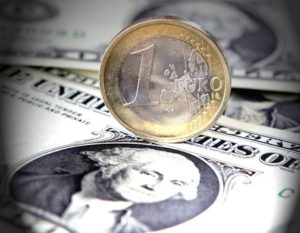 The euro traded little changed against the US dollar, even though the European Commission raised its GDP growth forecast for the euro zone in 2014.
The euro traded little changed against the US dollar, even though the European Commission raised its GDP growth forecast for the euro zone in 2014.
EUR/USD touched a session low at 1.3734 at 08:05 GMT, after which the pair traded little changed at 1.3739 at 10:42, losing 0.04% for the day. Support was likely to be received at February 25th low, 1.3715, while resistance was to be encountered at February 25th high, 1.3767.
According to data released by the European Commission yesterday, the gross domestic product in the euro zone will rise 1.2% this year, up from Novembers 1.1% forecast. The Commission also forecast the jobless rate to decrease to 12% this year, which however is the second-highest level in the history of the currency bloc. In addition, the gross government debt is projected to increase slightly to 95.9% of GDP.
The economy of the 18-nation common currency area, however, is projected to trail its main competitors, China and the US, in 2014 and 2015 as high levels of unemployment and debt hamper the euro areas recovery.
“The worst of the crisis may be behind us, but this is not an invitation to be complacent,” European Union Economic and Monetary Affairs Commissioner Olli Rehn told reporters today in Strasbourg, France, cited by Bloomberg.
The latest outlook clearly showed that the economic recovery remains fragile after the recent severe sovereign-debt crisis. Even though bond markets have stabilized and investor confidence is gaining traction, euro zone policy makers continue to face weaker growth and higher jobless rate than before the Global crisis started in 2008.
The European Commission also revealed its forecasts for the two biggest economies, the US and China. According to its estimates, the euro area projected growth for 2014 is not even close to the expected growth of 2.9% in the US and 7.4% in China.
However, demand for the 18-nation common currency remained under pressure, after on Monday it became clear that consumer prices in the euro area fell in January at the fastest pace since records began in 2001. Eurostat reported that the harmonized index of consumer prices for the euro zone declined by a record 1.1% in January after a 0.3% advance in the previous month. The annual inflation rate rose 0.8% last month, up from a preliminary estimate of 0.7% and after inflation increased by 0.8% in December. However, annual inflation remains near its weakest level ever and is less than half the ECB target of just below 2%.
The data suggested that consumer demand in the region remains weak and will probably continue to hamper economic development. The significant decline in the monthly consumer price index may prompt ECB’s policy makers to take action in order to stimulate the economy in the common-currency bloc as early as next meeting on March 6th, when the central bank is also going to publish its quarterly macro-economic forecasts, which will provide first inflation predictions for 2016.
Data scheduled to be released on February 28th may show that annual consumer prices rose 0.7% this month, signalling a fifth straight reading of inflation under 1%, which was referred by ECB President Mario Draghi as a danger zone.
Meanwhile, on Tuesday it became clear that confidence among consumers in the United States decreased significantly in February due to concerns over the short-term prospects regarding business conditions, employment and income. According to results from a survey by the Conference Board research group, encompassing over 5 000 US households, the corresponding index of consumer confidence slowed down to a reading of 78.1 in February, after the revised down value of 79.4 in January. Preliminary estimates pointed to an increase to 80.0 this month.
The index of economic expectations fell to a reading of 75.7 in February from 80.8 in the preceding month. The index of current assessment, on the other hand, rose to 81.7 this month, reaching its highest level in almost six years. In January it stood at 77.3.
A separate report by the S&P/Case-Shiller revealed that the index of home prices, which measures the change in selling prices of homes in 20 of the largest cities in the United States, climbed at an annualized rate of 13.42% in December from a year ago, compared to a 13.71% increase in the previous month, the biggest increase since February 2006. Analysts had projected a 13.38% advance. On a monthly basis, home prices dipped 0.1% in December in line with analysts’ forecasts and after another 0.1% drop in November.
New home sales in the United States, a key indicator for current housing market conditions, probably fell 3.4% to the annualized level of 0.400 million in January, according to the median forecast of experts, after in December sales reached the annualized 0.414 million. Official figures are expected to be released at 15:00 GMT today.
Elsewhere, having slid to a session low at 0.8970 at 0:09 GMT, AUD/USD managed to recover from losses to trade at 0.9018 at 7:25 GMT, dipping a mere 0.02% for the day. Support was likely to be found at February 24th low, 0.8938, while resistance was to be encountered at February 25th high, 0.9044.





